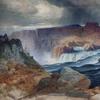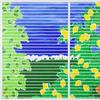Newly restored Putto with a Dolphin featured in "Verrocchio, Master of Leonardo" on view at the Palazzo Strozzi and Museo Nazionale del Bargello thanks to Friends of Florence
- FLORENCE, Italy
- /
- February 06, 2019
_1_Putto_col_delfino_Verrocchio434x650.jpg)
Exhibition will be on view in Florence, Italy, March 9‒July 14, 2019 before its presentation at the National Gallery of Art, Washington, D.C., September 29, 2019‒February 2, 2020
Florence, Italy…The Friends of Florence Foundation has underwritten the restoration of the Putto with a Dolphin (1470‒c.1475) a statue by Andrea del Verrocchio, for the exhibition Verrocchio, Master of Leonardo on view March 9‒July 14, 2019 in Palazzo Strozzi. The presentation will also have a special section in the Museo Nazionale del Bargello. Verrocchio’s influential practice as an artist, goldsmith, and architect led him to develop a studio renowned for training artists including Leonardo da Vinci. The statue that Lorenzo the Magnificent commissioned for the Medici family villa at Careggi and was later moved to Palazzo Vecchio where it is held today, will be among Verrocchio’s masterpieces displayed in the exhibition.
“The statue’s art historical significance and its presentation in the exhibition in Florence and, later, at the National Gallery in Washington D.C. make this project a particularly important one for our Foundation,” said Simonetta Brandolini d’Adda, co-founder and president of the nonprofit Foundation. “On behalf of the Friends of Florence, I thank our generous donors, Ellen and James Morton, who made the restoration possible, along with the city of Florence and the Fondazione Palazzo Strozzi for involving us in the conservation of an enchanting masterpiece by the great Florentine artist Verrocchio.”
The restoration, begun in 2018 and directed by Serena Pini curator of the Museo di Palazzo Vecchio, is being conducted by Nicola Salvioli and monitored by Jennifer Celani, official of the Soprintendenza Archeologia, Belle Arti e Paesaggio per la Città Metropolitana di Firenze e le Provincie di Pistoia e Prato.
The restoration of Putto with a Dolphin
The restoration of Andrea del Verrocchio’s (c.1435‒88) Putto with a Dolphin is the first scientifically based, conservation intervention done on the bronze sculpture since the 1950s when it was removed from the fountain on which it stood and placed inside the museum.

The restoration process, which is on view to the public in the Palazzo Vecchio museum, is not limited to the statue’s exterior. Rather, comprehensive diagnostic studies provided important information. Several mainly non-invasive scientific analyses made it possible to tailor the cleaning procedures, identify traces of several previous treatments, and, importantly, learn more about Verrocchio’s technique—one of the project’s specific goals.
The conservation of the bronze statue is an extremely complex process. The surface was darkened by residual matter from previous maintenance work and there was evidence of old restorations some of which were done with aggressive techniques and inappropriate substances. Underneath those treatments were harmful calcareous residue from water that splashed on the surface for centuries.
Careful inspection beneath the surface remedied deterioration and revealed heretofore unknown details. Gentle cleaning with aqueous solutions alternating with specific solvents make it possible to remove all previously applied layers and reveal the statue’s original surface. This enabled a better assessment of the extent of the damages caused by age, contact with water, and exposure to focus treatment on resolving the issues that altered the patina. Work included spot-elimination of harmful corrosive products and the mechanical removal of various residues. Cleaning the now-stable, protective patina of the bronze is bringing to light hidden details. The final steps will be harmonizing the surface colors to balance the overall appearance and the application of protective solutions to help conserve the bronze over the long term.
Photographic documentation includes images taken, before, during, and after the restoration, and videos of the restoration phases and results. Photographs include images obtained under the microscope and endoscopic views as well as 3D scans and graphic mapping.
Technical Management:
Serena Pini (Curator, Museo di Palazzo Vecchio - Musei Civici Fiorentini)
Oversight:
Jennifer Celani (Official of the Soprintendenza Archeologia, Belle Arti e Paesaggio per la Città Metropolitana di Firenze e le Provincie di Pistoia e Prato)
Restoration:
Nicola Salvioli, Florence
Diagnostic Studies:
Barbara Salvadori (Istituto per la Conservazione e Valorizzazione dei Beni Culturali - CNR Firenze) with Juri Agresti and Salvatore Siano (Istituto di Fisica Applicata “Nello Carrara” - CNR Firenze) for the analysis of the alloys; and Sonia Mugnaini, Siena for the analysis of the casting clays.
Documentation:
Antonio Quattrone, Nicola Salvioli
3D Scans and Mapping:
Nicola Salvioli
Exhibition Verrocchio, Master of Leonardo
Verrocchio, Master of Leonardo, on view March 9‒July 14, 2019 in Palazzo Strozzi and the Museo Nazionale del Bargello, will present masterpieces by Andrea del Verrocchio in fascinating dialogue with works by his predecessors, contemporaries, and followers including Desiderio da Settignano, Domenico del Ghirlandaio, Sandro Botticelli, Pietro Perugino, Bartolomeo della Gatta, Lorenzo di Credi, and Leonardo da Vinci. This year marks the 500th anniversary of Leonardo’s death and the Palazzo Strozzi exhibition will be one of the most important commemorative events to be held in the world.
Curated by two distinguished experts on 15th-century art, Francesco Caglioti and Andrea De Marchi, the exhibition will showcase more than 120 works—paintings, sculptures, and drawings—and will be the first-ever retrospective dedicated to Verrocchio. The exhibition is part of a collaborative undertaking involving museums and institutions in and around Florence and elsewhere that has led to major conservation campaigns that allow visitors to experience many masterpieces restored to original splendor. One of the most important projects is the restoration of Verrocchio’s bronze masterpiece Putto with a Dolphin on loan from its permanent home, the Palazzo Vecchio Museum, where it is being restored in a laboratory in the Sala della Cancelleria (Chancery) and visible to the public.
Verrocchio, Master of Leonardo is organized by the Fondazione Palazzo Strozzi and the Musei del Bargello in collaboration with the National Gallery of Art in Washington, D.C. where it will be on view September 29, 2019‒February 2, 2020, with the support of the Comune di Firenze, Regione Toscana, Camera di Commercio di Firenze, and a grant from the Fondazione CR Firenze. Intesa Sanpaolo is the main sponsor.
Andrea del Verrocchio (Andrea di Michele di Francesco Cioni; c. 1435‒88). Putto with a Dolphin, 1470‒c. 1475, bronze, 70.3 × 50.5 × 35 cm, Florence, Musei Civici Fiorentini – Museo di Palazzo Vecchio
The bronze statue of a winged boy standing on a partial sphere holding a wriggling dolphin is one of Verrocchio’s most famous and admired works. Inspired by Greco-Roman models and putti created by Donatello and his followers, this statue has extraordinary balance, motion, and dynamism.
A document dated 1496, drawn up after the death of his brother Tommaso, lists Verrocchio’s commissions for the Medici. It states that the “bronze boy” (bambino di bronzo), at the time complete with “3 bronze heads and 4 marble lion mouths” (3 teste di bronzo e 4 bocche di lione in marmo) was made for the Medici villa at Careggi. According to Giorgio Vasari’s art historical tome Lives (1568), it was commissioned by Lorenzo the Magnificent.
In 1557, Cosimo I had the putto moved to Palazzo Vecchio to crown the marble and porphyry fountain that Francesco del Tadda and Andrea di Polo were making based on designs by Bartolomeo Ammannati and Vasari for the center of the first courtyard, now known as the “Michelozzo Courtyard.” The statue stood there for four centuries, exposed to the elements and to the harmful effects of the water spouting from the dolphin’s mouth, as well as the stresses created by the various maintenance interventions that were conducted over time.
There is some partial documentation about three restorations done in the 20th century before the statue was moved indoors and replaced with a bronze copy by Bruno Bearzi. Initially, the Putto stood in the Sala della Cancelleria, and was later moved to the Juno Terrace to evoke the never-completed plans for the fountain that Cosimo I had wanted for the loggia (which has since been enclosed). The grand duke had ordered a painting of a winged gilded bronze putto with one foot on a dolphin’s head pouring water from a vase on the inside wall as a model for the fountain.
To allow visitors to the Museo di Palazzo Vecchio to witness the restoration work, the statue has been moved to the dedicated worksite set up in the Sala della Cancelleria.
Friends of Florence
Friends of Florence is a non-profit foundation supported by individuals from around the world who are dedicated to preserving and enhancing the rich cultural heritage of Florence and Tuscany and conserving irreplaceable artistic and cultural treasures. Friends of Florence identifies significant projects spanning centuries in need of restoration, secures funding, and works in collaboration with local authorities to complete projects.
Since its founding in 1998, the foundation has raised and donated $10 million for conservation projects in the region. Friends of Florence works directly with Florence’s famed conservation laboratories to ensure restoration is done at the highest level, has the approval of the City of Florence and the Italian Ministry of Art, and is completed on time and on budget.
Through its work, Friends of Florence creates opportunities for the study and appreciation of paintings, sculptures, architectural elements, places of worship, and collections at the Uffizi Gallery, the Accademia, the Baptistry, the Piazza della Signoria, the Museum of San Marco, and dozens of other museums, churches, and public sites.
A model of high-impact, low-overhead philanthropy, Friends of Florence is the primary source of funding for the city’s conservators, a respected partner with museums and cultural authorities in Italy and the U.S., and a publisher/producer of publications, multimedia offerings, seminars, lectures, and cultural travel opportunities.
Media contacts:
Friends of Florence
Italy
Elisa Bonini
elisaboniniitaly@friendsofflorence.org
mob. +39 3336729563
USA and world
Lisbeth Mark
Bow Bridge Communications, LLC, NYC
info@bow-bridge.com
Tel +1 347 460 5566
Fondazione Palazzo Strozzi
Lavinia Rinaldi
l.rinaldi@palazzostrozzi.org
Tel. +39 055 3917122
Antonella Fiori
a.fiori@palazzostrozzi.org
mob. +39 347 2526982
Musei del Bargello
Salvatore La Spina
s.laspina@operalaboratori.com
mob. + 39 331 5354957









_(17100x100_c.jpg)






